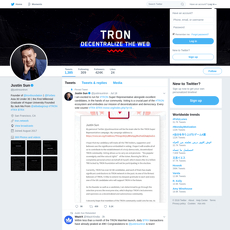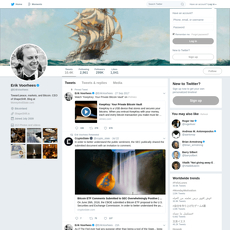joyce kim Review
joyce kim
twitter.com
Joyce Kim Twitter Review Guide: Everything You Need To Know About @joyce + FAQ
Curious if following @joyce is actually worth your time—or just one more account that clutters your feed?
I watch crypto Twitter like a hawk, and I know how easy it is to miss the good stuff while getting dragged into noise. If you’ve ever wondered whether Joyce Kim still posts, what she talks about, or whether her tweets can actually help you make better decisions, you’re in the right place.
Describe problems or pain
Here’s the challenge with high-profile crypto accounts in 2025: they’re a mix of legacy reputation, sporadic posting, and a swarm of lookalikes. With Joyce Kim specifically, most people hit the same roadblocks:
- “Is she still active?” You’ll see mentions of her early crypto work all over the web, but not everyone knows what she posts about now—or how often.
- “What exactly is she known for?” Headlines don’t give you the full picture of why her perspective resonates with founders, policy folks, and long-horizon investors.
- “Is her feed useful for me?” Traders, builders, and curious readers need different signals. It’s not obvious which group gets the most value from her posts.
- “Is this the real account?” Impersonators, underscore handles, and fake “airdrops” muddy the waters. Chainalysis has repeatedly flagged social-engineering scams and impersonation as persistent threats in crypto communications.
Real talk: On X/Twitter, a short, highly desirable handle like @joyce attracts impersonators. New accounts with her photo, a fresh join date, and “recovery” or “airdrop” links are classic red flags.
And the bigger meta-problem? Even legit feeds can waste your time. Threads that look smart but lead nowhere, vague takes that don’t translate to action, and hot takes that age badly—these all eat attention without giving you signal.
Promise solution
Let’s keep it clean and practical. I’m going to show you exactly how to get value from following @joyce without getting sucked into scroll hell.
- Who she is and why people follow her: A quick, up-to-date snapshot so you know whether her perspective fits your goals.
- What to expect in her feed: The recurring themes you’ll actually see, not just what bios and interviews say.
- How often she posts and how “actionable” it is: Whether you’re getting timeless strategy, market signals, or founder-focused insights.
- How to verify the real account fast: Simple checks anyone can do in under a minute—handle, cross-links, and history patterns—to dodge fakes.
- How to set alerts without spam: A lightweight setup with Lists, thread notifications, and saved searches so you see the good stuff and skip the fluff.
If you want a high-signal follow that you can set and forget—checking in only when it matters—this guide will get you there.
How I judge crypto Twitter accounts
I score accounts on four pillars. This isn’t academic; it’s built to help you decide in under five minutes whether to follow, list, or skip.
1) Credibility & track record
What I look for: Shipped products or org leadership, consistent contributions, references from respected builders, and clear receipts (talks, articles, code, org history).
What earns a high score: Publicly verifiable roles, thoughtful posts that aged well, and no pattern of pump-and-dumps or quietly deleted hot takes.
2) Signal-to-noise
What I look for: Posts that add context or new information vs. reactive commentary. Ratio of threads with insights to memes, subtweets, or link spam.
Pro tip: If 70%+ of recent posts are original thinking or useful curation, that’s strong signal.
3) Usefulness by reader type
What I look for: Is the account more valuable to founders, policy watchers, researchers, or traders? I map content to goals (e.g., product strategy, governance, market structure, regulation).
Why it matters: A great account for founders might be low-yield for day traders—and that’s okay if you set expectations right.
4) Transparency of affiliations
What I look for: Clear disclosures about investments, board seats, advisory roles, or personal stakes when discussing related topics.
Green flags: Pinning a disclosure thread, linking portfolio pages, or noting conflicts in-line (“I invested,” “I advise,” etc.).
Each pillar gets a 1–5 score, then I summarize the fit by reader type. I’ll apply this framework to @joyce so you can make a fast, confident call.
Heads-up on safety: Crypto-related identity scams on social platforms are still rampant, and multiple academic and industry analyses show non-trivial bot and impersonation activity around market events (Botometer/Indiana University, Chainalysis). Always verify handles, check mutuals, and be skeptical of DMs requesting funds or “recovery help.”
Ready to find out who Joyce Kim is in crypto terms today—and why her perspective still gets attention? Let’s look at the background that actually matters next.
Who is Joyce Kim? Background and why crypto cares
If you’ve been around crypto long enough to remember 2014, you’ve seen the name Joyce Kim show up at real inflection points. On Twitter, she’s @joyce — a short handle with a long trail of building, advising, and pushing for practical, real-world use of crypto rails.
"Follow people who have built through cycles. They speak from scar tissue, not headlines."
Quick bio and milestones
Here’s the fast context that matters when you’re deciding whether her timeline is worth your attention:
- Co-founded Stellar (2014): Joyce is widely known for co-founding the Stellar network alongside Jed McCaleb, with an early focus on low-cost cross-border payments and financial access. She served in a leadership role at the Stellar Development Foundation during its formative years.
- Operator before and after protocols: Before Stellar, she co-founded a consumer tech startup and worked hands-on in product — the kind of experience that shows up when she talks about onboarding and UX in crypto. After Stellar, she’s been active as an investor and advisor, especially with early-stage founders in fintech and web3.
- Financial inclusion and real-world rails: Her early public work highlighted remittances, NGO disbursements, and settlement use cases — not just token price action. That angle still shapes the way she talks about crypto’s purpose.
- Visible in the ecosystem: Over the years, she’s appeared in interviews and panels on product strategy, regulation, and founder execution — not as a “talking head,” but as someone who’s shipped.
If you want a refresher on Stellar’s original mission and why it mattered, the foundation still frames it simply: open financial infrastructure that connects people, banks, and payment systems. That’s the lens Joyce is known for.
Current focus and activity
From her recent public footprint and what shows up on Twitter, a few patterns stand out:
- Founder-first content: She gravitates to the zero-to-one stage — hiring, product-market fit, distribution, and the emotional realities of building through market noise.
- Policy and market structure: Expect reactions to regulatory shifts and market plumbing (custody, compliance, payment corridors) rather than pure price commentary.
- Tech signals that matter: Infrastructure that reduces friction (settlement times, fees, identity, on/off-ramps) gets her attention more than hype cycles.
- Posting style: Not a daily “thread machine.” She posts in focused bursts, boosts useful founder resources, and engages when there’s substance. It’s quality over volume, which is exactly why people keep her on lists.
In short, if you’re building or evaluating products, her feed tends to surface the practical edges — where a protocol meets a P&L.
Why her voice matters
Two things make Joyce Kim’s perspective stand out in crypto’s noisy timeline:
- Operator + protocol POV: She’s worked at the messy intersection of product, policy, and payments — which means her takes usually account for users, regulators, and developers at the same time. That blend is rare and valuable.
- Mission without naivety: The financial access narrative is easy to say and hard to ship. Her history with cross-border payments and NGO payout rails keeps the conversation anchored to actual users and distribution — not just whitepapers.
Who benefits most from following her?
- Early-stage founders: You’ll pick up hiring heuristics, product checkpoints, and hard-won advice on partnerships and go-to-market.
- Policy watchers and operators: You’ll see where regulation meets product reality, especially around compliance and payments rails.
- Long-horizon investors: If you care about infrastructure and adoption curves over quarters (not days), her signal helps frame what to pay attention to.
There’s also a practical trust angle here. Year after year, the Edelman Trust Barometer finds that industry and technical experts rank among the most trusted sources of information online. That’s the type of voice her account represents — not hype, not PR, but practiced judgment.
So what does all this look like in your feed? Next up, I’ll show you exactly what shows up on @joyce — themes, posting rhythm, and whether it’s actionable for you right now.
Is @joyce on Twitter worth following?
Short answer: yes, if you care about product thinking, founder execution, and where crypto policy meets real users. Her feed isn’t a meme firehose. It’s selective, practical, and occasionally sharp in a way that helps you make cleaner decisions.
“Attention is a currency. Spend it where the return compounds.”
What you’ll actually see in her posts
Expect signal that skews builder-first and policy-aware, with a macro-tech lens. Typical themes I see:
- Founder advice that travels: tight notes on hiring early operators, PMF tests that don’t waste quarters, and how to talk to users without bias. Think prompts like “What would break if you 10x’ed users this week?”
- Product/market takes: clear views on what actually reduces friction for wallets, payments, or on/off-ramps; why some UX “fixes” create regulatory exposure; and when a protocol decision is really a product decision in disguise.
- Governance and policy: context on how rules get written, what a hearing or enforcement action means for builders, and when to build with policy in mind vs. keep your head down.
- Tech landscape signals: crossovers from AI, fintech, and infra—e.g., where new compliance tooling or LLM agents change onboarding, fraud, or support costs.
Real-world flavor you might catch: a short thread urging founders to publish a risk register for compliance blind spots; a take on shipping “minimum trustworthy product” before “minimum viable product”; or a blunt reminder that governance docs are product docs when users rely on them.
Posting frequency and signal-to-noise
Cadence is light to moderate. She posts when there’s something to say—more thoughtful threads than daily filler. The signal-to-noise is strong because there’s little engagement farming. Expect:
- Threads with context over quick dunking
- Builder-relevant links (policy memos, product postmortems)
- Actionable takeaways you can apply the same week
If you want minute-by-minute trading setups, this isn’t it. If you want your next product decision to be less dumb, this helps.
Verifying the real account
Impersonations are real—and fast. A well-cited study in Science found false news spreads “significantly farther, faster, deeper” on Twitter than true stories (MIT/Science, 2018). Do a 60-second check:
- Handle: the real one is @joyce. Watch for lookalikes like @joyce_ or @joyceKlm.
- History: scroll back years. Real accounts have long, consistent timelines and old replies with recognizable builders.
- Cross-links: look for the handle linked from long-standing profiles—conference bios, podcasts, or organization pages associated with her past roles. Consistency matters more than paid verification.
- Network tell: check who follows her. If respected founders, policy folks, and early crypto operators follow and interact, that’s a strong signal.
- Search trick: use “from:joyce since:2015-01-01” to spot the historical footprint.
Also useful: treat any account DMing you first or pitching tokens as an impostor. High-signal voices don’t cold DM “opportunities.”
Getting the most value with minimal time
Here’s how I keep the juice and cut the noise:
- Add to a focused List: create a List called “Product + Policy.” Keep it tight (under 30 accounts). Open it instead of Home to avoid doomscrolling.
- Turn on Highlights, not all notifications: tap the bell on @joyce and pick Highlights so you catch notable threads without every like/reply.
- Save the good stuff for action: Bookmark threads, then tag them in your notes (Notion/Obsidian/Apple Notes) under “PMF,” “Gov/Policy,” or “Team.” Reviewing saved notes beats searching your memory.
- Use advanced search like a pro:
- from:joyce -filter:replies min_faves:50
- from:joyce “governance” OR “policy”
- from:joyce filter:links (to surface research or docs)
- Set a 10-minute cadence: two List check-ins per week. If a thread changes your roadmap, it was worth it; if not, skip.
One more reason to prune your follow list: a recent report by Pew shows a large share of X users get news on-platform, which raises the cost of low-quality follows (Pew Research Center, 2023). High-signal accounts amplify your returns; low-signal ones tax your focus.
Pro tip: when a policy event breaks (hearings, rule proposals), run a saved search with “from:joyce (hearing OR rule OR policy)”—you’ll get context, not just headlines.
Curious how her crypto story actually fits into the bigger timeline—and what people often get wrong about it? That’s where we’re headed next.
Joyce Kim’s role in crypto: facts, context, and common misconceptions
I keep seeing the same myths about Joyce Kim float around Crypto Twitter. Here’s the clean, factual backdrop so you can read her feed with the right lens—and not get pulled into rumors or recycled narratives.
Timeline snapshot
- 2013: The SimpleHoney team (which Joyce co-founded) joins Ripple Labs to work on consumer payment experiences—her first public step into crypto/payments.
- 2014: Co-founds the Stellar Development Foundation (SDF) with Jed McCaleb; launches Stellar with a mission geared toward global payments and financial access.
- 2014–2015: Early ecosystem-building: community distribution plans, outreach with partners, and public education on cross-border payments. Stripe’s seed support for SDF is announced during this period.
- 2015–2016: Stellar evolves its consensus approach—David Mazières’ Stellar Consensus Protocol (SCP) comes to the foreground. Joyce transitions out of day-to-day leadership around this arc while SDF keeps scaling.
- Post-2016: Continues in crypto as an investor/advisor and a public voice on founders, product strategy, and policy—less hands-on with SDF operations, more focused on broader ecosystem work.
Dates above are drawn from public announcements and archived interviews. If you care about precision, map them against SDF releases, archived blog posts, and conference records—it lines up.
Contributions that people cite
- Co-founding SDF and its mission: Helped set the early mandate around real-world payments and financial inclusion—the “why” behind Stellar’s public-good posture.
- Ecosystem and partnership groundwork: Those first years matter; Joyce was often the public-facing voice explaining how anchors, corridors, and user-friendly products could stitch into a credible payments network.
- Consumer protection and policy fluency: She’s consistently pushed for clarity on KYC/AML, remittances, and safeguards for everyday users—an angle that still shows up in her posts and interviews.
- Founder-first perspective: Advice on hiring, shipping, and staying focused in chaotic markets; when she tweets, it’s often to give practical direction rather than chase sentiment.
- Representation and access: Known for championing underrepresented founders in crypto and adjacent tech—something you’ll notice in who she amplifies and the programs she highlights.
When I scroll her historical posts, I see fewer “price-go-up” takes and more “here’s how to build something people can actually use.” That’s a pattern, not a one-off.
“The internet rewards speed; crypto rewards patience. Choose your mentors accordingly.”
What people often get wrong
- “She still runs Stellar.” No. She co-founded SDF and was an early executive. Leadership has changed hands; Denelle Dixon has been CEO of SDF since 2019. Joyce’s current role is not day-to-day at SDF.
- “Joyce = Ripple.” She worked on consumer payments after her team joined Ripple in 2013, then co-founded Stellar in 2014. Different missions, different consensus, different orgs.
- “She tweets like a trader.” Not really. Her cadence is lower, with higher signal density—builder and policy energy over rapid-fire market calls.
- “She talks about XLM price.” Rarely. Expect product, policy, founder guidance, and broader tech context—not charting.
- “Low posting = not active in crypto.” Posting volume isn’t involvement. She tends to surface when there’s a real point to make.
If you’ve been expecting influencer-style frequency, you’ll misread the value. It’s closer to, “bookmark it and check when you need a sanity check,” than “open every hour.”
Neutral context when controversy comes up
Crypto memories are short; screenshots live forever. When you see drama tied to Joyce or Stellar, here’s how I keep it clean:
- Start with primary sources: SDF announcements, GitHub repos, archived blogs, conference videos. Compare dates to see who decided what, and when.
- Separate protocol from personalities: The Ripple–Stellar split is ancient by crypto standards. Focus on design choices (e.g., SCP, anchors, distribution) and outcomes, not team gossip.
- Check leadership timelines: Many hot-button decisions (like later token supply changes) happened after Joyce’s day-to-day tenure. Don’t time-warp.
- Watch for velocity bias: Fast takes spread faster than true takes. An MIT study in Science (Vosoughi, Roy, Aral, 2018) showed false news diffuses farther and quicker on Twitter than the truth. Build in a pause.
- Use search like a pro: Try from:joyce “keyword” with a date range to see her own words in context. If the take you’re reading isn’t quoting primary sources, treat it as entertainment.
I’ve found that 10 minutes of source-checking beats hours of thread wars. And if two stories disagree, the timeline usually solves it.
Real-world example: During debates about Stellar’s distribution and the early switch to SCP, lots of posts tried to connect long-tail outcomes back to individuals who’d already moved on. Pull the dates: protocol papers, SDF leadership updates, and release notes give you the actual sequence. It’s less spicy, but it’s true.
One last thing: mainstream studies also show how a small slice of accounts dominate posting. Pew Research Center has reported that a tiny share of users generates the majority of tweets. Translation—loud isn’t the same as right. When Joyce weighs in, it’s usually to add context, not to add volume.
If you’re wondering how all this translates into quick answers—like whether she’s still active, what she tweets about most, or how to confirm you’ve got the real @joyce—I’ll make that painless next. What’s the fastest way to verify her handle and avoid impersonators without falling down a rabbit hole?
FAQ: Quick answers people look for about Joyce Kim and @joyce
“Follow for the edge you can apply in one hour, not for the drama you’ll forget in one minute.”
Who is Joyce Kim in crypto terms?
Joyce Kim is best known in crypto for co-founding the Stellar Development Foundation alongside Jed McCaleb, helping shape one of the earliest open networks focused on global payments and financial access. Beyond that, she’s spent years advising founders and working across product, policy, and markets—so her perspective connects early-stage building with real-world adoption.
Is Joyce Kim still involved in crypto?
Based on recent public activity and the topics she engages with, yes—she remains active as a founder-focused voice who tracks product strategy, market structure, and policy. She isn’t posting day-trade signals; think higher-level insight that’s useful for builders, long-horizon investors, and people watching regulation and infra.
Is @joyce the real account? How do I confirm?
Quick checks I use anytime I verify a high-profile handle:
- Start here: the handle is @joyce.
- Cross-links: Look for the handle linked from reputable sources she’s been associated with (e.g., Stellar.org blog archives, conference speaker pages, credible interviews). Cross-verification beats checkmarks.
- History and network: Check the account’s long posting history, media mentions, and who follows/interacts (well-known founders, policy folks, and early crypto builders).
- Ignore the badge: A blue check on X is pay-to-verify now. Don’t rely on it alone.
- Spot the fakes: New accounts with lookalike names, extra characters, or AI headshots are red flags.
- When in doubt: Use platform resources: Report impersonation and Advanced search to check long-term consistency.
What topics does she tweet about most?
- Founders and product: hiring, early product decisions, PMF reality checks, leadership.
- Crypto policy: regulatory direction, implications for builders and exchanges.
- Market structure: on-chain infra, payment rails, consumer adoption friction.
- Tech trends: platform shifts, AI’s impact on product and distribution.
Expect more “how leaders think and ship” than “which token pumps next.”
Is her feed useful for traders?
If you’re short-term trading, her posts won’t hand you entries. Where traders do get value:
- Macro and policy shifts: early reads on regulation that can impact sector flows.
- Sentiment checks: how experienced operators are thinking about product-market reality versus hype.
- Narrative timing: hints on infra or consumer unlocks that can set up medium-term themes.
Practical tip: pair her feed with your own alerts for policy hearings, stablecoin bills, and L2/ecosystem milestones to turn strategic takeaways into watchlist triggers.
How can I contact her or get on her radar?
- Reply with substance: Add one insight, metric, or relevant source—avoid hype or asks.
- DMs: If they’re open, send brief, useful context (what, why it matters, and a credible proof link). No attachments on first contact.
- Tag with purpose: If you share a thread/paper/tool that directly supports a topic she’s discussing, add a one-line summary so it’s skimmable.
- Warm path: A short intro from a mutual who vouches for your work travels much further than cold outreach.
Best way to catch her most useful threads
- Add her to a high-signal List: Keep a “Policy + Founders” list so you can batch-read without feed noise.
- Turn on notifications selectively: Enable alerts for @joyce, then mute keywords you don’t care about to keep signal clean.
- Save and resurface: Bookmark standout threads and drop them into a notes doc with a one-line takeaway so you actually use them later.
- Use Advanced Search: Helpful filters to surface meatier posts:
- from:joyce min_faves:100 — higher-engagement ideas
- from:joyce filter:replies min_replies:5 — active discussions
- from:joyce (policy OR regulation OR “market structure”) — targeted topics
If you’re building a smart follow list, the next question is simple: who complements @joyce so you get rounded coverage without duplicating noise? Let’s compare her signal to adjacent voices you’ll actually want in your feed next.
How @joyce compares to similar voices you might follow
I keep a tight, high-signal follow list, and I’m picky about how each voice fits. Here’s how I position @joyce next to adjacent accounts so you get coverage across product, policy, research, and market context without clogging your feed.
Complementary follows
Pair @joyce with a few focused voices so your timeline covers the angles she often sparks: founder execution, policy risk, and product strategy.
Founder/Product builders- @cdixon — Big-picture crypto/product arcs. Good counterbalance when @joyce is talking practical founder moves; Dixon adds where the arc might go next.
- @gokul — Clean product/GTMP frameworks. Not crypto-only, but perfect for translating @joyce’s founder notes into concrete product checklists.
- @shreyas — High-signal product leadership and decision-making. Great pairing when @joyce touches hiring, org design, or PMF.
Policy and market structure- @jchervinsky — Clear breakdowns of U.S. crypto policy moves. Use alongside @joyce to separate short-term noise from real regulatory risk.
- @jerrybrito — Coin Center’s take on legislation and civil liberties. Handy when you want primary-source context for policy threads you see.
- @brian_armstrong — Operator-level signals on compliance, consumer adoption, and exchange policy battles.
Research and ecosystem metrics- @ElectricCapital — Dev activity reports and ecosystem data. When @joyce highlights a trend, check if the builder numbers back it up.
- @MessariCrypto — Research snapshots, market structure explainers, and sector maps for quick validation.
- @paradigm — Technical research and governance posts. Useful to stress test strategic takes with first-principles analysis.
Macro/context- @matthew_pines — Macro and geopolitics that influence policy tempo and liquidity cycles. Good for timing when @joyce flags strategic inflection points.
Why this mix works: founder-and-policy voices tend to create outsized value per minute when combined. In practice, I’ll read a product or founder note from @joyce, sanity-check policy ripple effects via @jchervinsky or @jerrybrito, then verify if builders are actually shipping in that area via @ElectricCapital. That three-step pass keeps my feed from becoming a “hot takes” machine.
When to prioritize @joyce
There are windows where her perspective jumps to the front of the queue. I bump her to the top of my List when I’m:
- Building or advising at pre-seed/seed — You’ll often get crisp thinking on PMF, early hiring, and product velocity. If you’re deciding between shipping a wedge vs. chasing a full platform vision, her take can save you cycles.
- Watching policy with founder glasses on — During hearings, enforcement actions, or cross-border clarity moments, her lens is “What should a builder do next?” not just “What happened?”
- Stress testing go-to-market — When consumer UX or distribution is the blocker, her notes tend to be practical: who the user is, what they actually want, and which assumptions are fluff.
- Thinking about leadership — Hiring, board dynamics, and stakeholder management show up in her feed in ways that help founders avoid common traps.
Examples of how I use this in real time:
- New policy headline? I check @joyce for the founder impact, then hop to @jchervinsky for legal nuance, and last to @MessariCrypto for sector-level exposure.
- Product debate in my portfolio? I’ll scan @joyce for the principle, @gokul for the framework, and search @ElectricCapital for dev momentum in that stack.
My verdict by reader type
- Builders and operators — Follow now. Turn on notifications for threads only. Pair with @gokul and @ElectricCapital so strategy and execution stay tethered to real-world product and dev data.
- Researchers/analysts — Follow and add to a “Founder x Policy” List. Use Advanced Search operators (from:@joyce "go to market", from:@joyce policy) to pull historical context fast.
- Investors (early-stage to growth) — Follow. Keep her in your “Sourcing + Signals” List; skim during policy/news spikes and product paradigm shifts to sharpen theses.
- Traders — Add to a curated List. Check during macro or regulatory volatility for sentiment shifts and second-order effects, but don’t expect trade calls.
- Curious newcomers — List first, follow later. Read a few weeks of posts to see if the founder-policy blend matches what you want to learn.
Pro tip: Balance your follow graph with 1–2 founder voices, 1–2 policy sources, and 1 research account. A smaller, high-credibility set reduces noise and improves recall when you actually need the information.
Want to see how I set up Lists and notifications so this mix stays high-signal without eating my day? I’ll show you exactly how I wire it up next—ready for a 5-minute setup that pays dividends all year?
Final take and next steps
If you want sharp product thinking with a real crypto track record behind it, follow @joyce. You won’t get daily hype; you’ll get perspective that helps you build better, spot policy shifts earlier, and read the market with more context. Set it up once, keep your feed clean, and her posts become a high-signal layer in your workflow—not another tab you feel guilty about ignoring.
Who will get the most value
- Builders and product-minded operators: Practical takes on product, founder execution, and what actually moves users.
- Policy watchers: Useful context on regulation, governance, and where incentives collide.
- Long-horizon investors: Good for thesis shaping and spotting inflection points, not scalp-level entries.
- Traders: You can still pull macro and sentiment cues when she comments on market structure or policy timing.
Pro tips to keep your feed sharp
- Create a focused List (2 minutes):
- Make a List called Product + Policy Core and add @joyce.
- Add 5–10 complementary voices so you see triangulated signals without the noise.
- Pin the List timeline and check it instead of Home. This single change cuts junk dramatically.
- Only surface her deeper posts (no spam pings):
- If you use X Pro (pro.twitter.com), add a search column:
from:joyce -is:retweet min_replies:3
That approximates “threads only,” so you get notified when she’s publishing substance. - Want higher bar? Use: from:joyce -is:retweet (min_faves:50 OR min_retweets:10).
- If you use X Pro (pro.twitter.com), add a search column:
- Mute the time-wasters (30 seconds):
- In Settings → Privacy and safety → Mute and block → Muted words, add:
gm, wagmi, giveaway, airdrop, wen, ref link, price target, 100x - This won’t touch her posts; it just trims your broader feed so her signal stands out.
- In Settings → Privacy and safety → Mute and block → Muted words, add:
- Bookmark and file for later (so insights don’t vanish):
- Use native Bookmarks plus folders if you have Premium, or share links to a tool like Pocket, Readwise Reader, or Notion.
- Keep three buckets: Founder Tactics, Policy Signals, Market Structure. File in under 10 seconds. Future you will thank you.
- Pull up her best posts on demand:
- Advanced search combos:
from:joyce product -is:retweet
from:joyce (policy OR regulation) -is:retweet
from:joyce -is:retweet min_faves:100 - These queries surface evergreen takes fast when you’re researching or writing.
- Advanced search combos:
- Timebox your attention (backed by research):
- Set two small windows—say, 10 minutes morning and afternoon—to scan your List and file one takeaway. That’s it.
- Why: studies on attention show interruptions crush focus and raise stress. UC Irvine research led by Gloria Mark has measured how digital interruptions can derail work and lengthen recovery time; more recent work suggests average on-screen focus often drops under a minute. Treat notifications as a controlled input, not a firehose.
- Run a 30-day “signal check”:
- At the end of the month, look at your saved items. If you bookmarked 5+ of her posts and used at least one in a decision, keep notifications. If not, shift her to List-only.
- Verify once, then forget it:
- Confirm the handle is @joyce and cross-check links from reputable profiles or org bios. Scan account age and history consistency. After that, ignore impersonators.
“Don’t try to read everything. Decide what you want from a follow, set the filter once, and let the good stuff come to you.”
Your call, made simple
Follow @joyce if you want smart, product-first perspective grounded in real crypto experience. Put her in a focused List, set a thread-only column if you use X Pro, mute the fluff that eats your day, and save the posts that matter. Do a 30-day check: if her ideas improved your decisions—even a little—you’ve added a real signal to your stack.
That’s the whole goal: fewer tabs, better inputs, stronger outcomes.
CryptoLinks.com does not endorse, promote, or associate with Twitter accounts that offer or imply unrealistic returns through potentially unethical practices. Our mission remains to guide the community toward safe, informed, and ethical participation in the cryptocurrency space. We urge our readers and the wider crypto community to remain vigilant, to conduct thorough research, and to always consider the broader implications of their investment choices.













